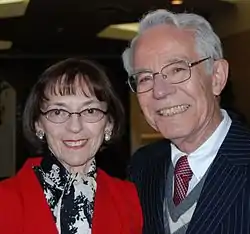David Lieber
Dr. David L. Lieber, rabbi and scholar, was president emeritus of the University of Judaism (now known as the American Jewish University)[1] and the senior editor of the Etz Hayim Humash.[2] He helped pioneer the Ramah camps, serving as the founding head counselor in the first of the camps in Wisconsin, a director in Maine, the founding director of Camp Ramah in California, and the founding director of the Mador.[3]

Biography
Early life
Dr. Rabbi David Leo Lieber was born in Poland on February 20, 1925 in the town Stryj (the city is now part of Ukraine).[4][5] His parents, Max and Gussie Yarmush Lieber, moved with him to the United States, when he was two years old.[4][5] The family spent some time on a relative's farm before ultimately settling in the Lower East Side of Manhattan, where David grew up.
Education
At age 19, he graduated from the City College of New York while simultaneously receiving a bachelor's degree in Hebrew literature from the Jewish Theological Seminary (JTS).[5] In 1947, at age 22, he earned his master's in philosophy from Columbia, and he received his ordination from JTS a year later, in 1948.[5] In 1951, he received a doctorate in Hebrew literature from JTS.[5] His dissertation was on Tehilim, which he loved.
Family
David met the love of his life and wife of 63 years, Esther Kobre, through her brother, with whom he was good friends, and also through Hashomer Hadati (now Bnei Akiva). In 1943, when David Lieber was 18 and Esther Kobre was 16, they became engaged, and they married two years later on June 10, 1945.[6] Drs. David and Esther Lieber had four children: Michael, Daniel, Deborah, and Susan.[4][5]
Career
From 1950 to 1954, he served as rabbi at Sinai Temple in Los Angeles.[4][5] From 1954 to 1956 he served as chaplain in the U.S. Air Force.[3] In 1956, he was named Dean of Students at the University of Judaism.[4][5] In 1964, he was named president of the University of Judaism, a post which he held for 29 years.[4][5] As the university's first full-time president, Dr. Lieber oversaw the institution's expansion and established its rabbinic program, the first on the West Coast for Conservative Judaism, as well as its MBA program for non-profit management.[7] When he stepped down as president in 1993, David Lieber was one of the nation's longest-serving college presidents.[4] His career did not end with his retirement. After stepping down from the post of president, Dr. Lieber continued to teach as the Flora and Arnold Skovron Distinguished Service Professor of Biblical Literature and Thought at the UJ, he served as president of the Rabbinical Assembly from 1996 to 1998, and he also served as senior editor for the Etz Hayim Humash, the first official Torah and commentary of the Conservative Movement.[4][5][8] Dr. David Lieber first conceived of the idea of writing the Etz Hayim Humash in 1969,[8] in order to create a "new Torah commentary to reflect the age in which it is made,"[5] but began working on the project eighteen years later, in 1987.[8] The Etz Hayim Humash is more accepting of biblical criticism than the Humash previously used by the Conservative movement, the Hertz, containing a number of essays which challenge the historicity of some of the biblical narratives.[5] It also reduces the frequency with which the word "He" is used to describe God.[5] Dr. David Lieber described his work on the Etz Hayim Humash as "a great privilege"[8] and stated that he "worked with great scholars," and "Just seeing how they worked was an inspiration. It was a great honor and zechut, merit. It is a great joy to see it done."[8]
Awards
2002: National Jewish Book Award in the Nonfiction category for Etz Hayim: Torah and Commentary[11]
See also
References
- Honored Colleague - Rabbi David Lieber by AJU
- Publications Humash by the Rabbinical Assembly
- David Lieber, PhD Archived 2011-07-18 at the Wayback Machine by AJU
- Woo, Elaine (December 16, 2008). "Rabbi David L. Lieber dies at 83; president emeritus of American Jewish University". Los Angeles Times.
- Hevesi, Dennis (December 20, 2008). "Rabbi David Lieber, Scholar and University President, Dies at 83". The New York Times. Retrieved May 1, 2010.
- CONGRESSIONAL RECORD— Extensions of Remarks E129
- Woo, Elaine (December 20, 2008). "David Lieber; edited a new Torah commentary". The Boston Globe.
- The Lieber Humash Archived 2011-07-18 at the Wayback Machine by the AJU
- "Remembering Esther Lieber | OBITUARIES AND SERVICES - Mount Sinai Memorial Parks and Mortuaries". Retrieved 2017-10-01.
- "Hebrew Date Converter - 29th of Tevet, 5777 | Hebcal Jewish Calendar". www.hebcal.com. Retrieved 2017-10-01.
- "Past Winners". Jewish Book Council. Retrieved 2020-01-24.
